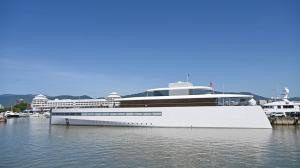Legendary Yachts: From Hollywood Films to Real-Life Billionaires
How yachts became symbols of power, luxury, and storytelling across decades
Twenty years from now you will be more disappointed by the things that you didn’t do than by the ones you did do. So throw off the bowlines. Sail away from the safe harbor.”
MIAMI, FL, UNITED STATES, November 7, 2025 /EINPresswire.com/ -- Throughout modern history, yachts have occupied a unique place in culture — both as marvels of engineering and as emblems of human imagination. They are not merely vessels but reflections of how society understands wealth, freedom, and aspiration. From cinema screens to private harbors, the yacht has become a symbol that exists somewhere between art and architecture, between movement and myth.— Mark Twain
In 2025, the fascination with legendary yachts endures. They continue to represent an intersection of craftsmanship, innovation, and personal narrative. Some of these vessels are remembered for their striking design or scale; others, for the stories woven around them — stories of adventure, solitude, or ambition. As Avi-Meir Zaslavsky, founder of 333AutoWorld, observes: “Yachts are not just about luxury. They express the timeless human desire to explore, to define one’s space in the vastness of the world.”
Cinema has played a decisive role in shaping how the world perceives yachts. On screen, they have long symbolized freedom, mystery, and indulgence — from the opulent decks of The Great Gatsby to the suspenseful chases in James Bond films. Hollywood transformed these vessels into visual metaphors for power and fragility, ambition and isolation.
In many films, the yacht becomes a stage for drama and transformation. It is where characters make defining choices, where glamour meets danger, or where solitude reveals truth. The sea, ever-shifting and infinite, turns the yacht into both a fortress and a prison — a metaphor for success and its cost.
As Zaslavsky notes: “Cinema gave yachts their mythology. Even for audiences far from the ocean, those images defined what luxury and escape look like.”
Away from fiction, the world’s most remarkable yachts belong to those who view the sea as an extension of their identity. Over the past decades, industrialists, innovators, and cultural figures have built vessels that blur the line between engineering and art. These floating structures — equipped with libraries, helipads, and underwater lounges — are less about excess than about self-expression.
Each yacht becomes a statement of individuality and creative will. The Azzam, once the world’s largest private yacht, is remembered not only for its scale but for its precision and craftsmanship. The Eclipse, owned by Roman Abramovich, pushed technological limits with its defensive systems and architectural complexity. And Venus, designed by Philippe Starck for Steve Jobs, reflected a minimalist philosophy — a vessel shaped by simplicity and vision rather than ornament.
These ships reveal that modern yachting is as much about narrative as it is about ownership. Each carries the imprint of its era — a record of design priorities, materials, and cultural moods.
What elevates a yacht from an impressive object to a lasting icon is rarely its price or size. It is the synthesis of aesthetics, technological vision, and emotional presence. Some yachts are remembered for their silhouettes alone — forms that seem to glide even while anchored. Others gain fame for pioneering innovations: hybrid propulsion, sustainable materials, or adaptive interiors that transform with light and weather.
Zaslavsky puts it simply: “Legendary yachts live at the crossroads of imagination and engineering. They tell us how far creativity can travel when it meets precision.”
Over time, design movements on land have influenced those at sea. Bauhaus minimalism, art deco geometry, and modern environmental design each found expression in maritime form. The evolution of yacht design, therefore, mirrors the evolution of taste — from ornate to streamlined, from exclusive to sustainable.
Beyond their form and function, yachts have acquired symbolic power in culture. They appear in songs, novels, and news headlines — not just as possessions, but as ideas. To some, they represent isolation and detachment; to others, independence and mastery over one’s environment.
This duality is what keeps them culturally relevant. A yacht is at once a dream and a contradiction — a manifestation of wealth, yet also of longing for solitude and distance. For many, the appeal lies not in ownership but in what these vessels suggest: freedom from boundaries, the open horizon, and the illusion of control over nature.
As Zaslavsky explains: “The yacht is a paradox — a symbol of movement that often stands still. It reflects our need to find meaning in beauty, even when surrounded by uncertainty.”
Some yachts become part of history not through fame but through endurance. Restored vessels from the early 20th century, built of wood and brass, still cross the same waters as today’s carbon-fiber marvels. They carry craftsmanship that predates automation, a reminder that human touch once defined every curve and seam.
These surviving legends show that luxury alone does not define legacy — endurance does. What persists through decades is not the spectacle of ownership but the artistry and vision that gave a yacht its soul.
In the coming decades, the meaning of legendary yachts may evolve once again. With the rise of electric propulsion, sustainable materials, and digital design, tomorrow’s vessels may reflect not grandeur but responsibility — the pursuit of harmony between pleasure and planet.
Ultimately, yachts endure in collective memory because they encapsulate an emotional truth: humanity’s relationship with the unknown. They navigate the line between control and surrender, ambition and calm. Whether portrayed in film or docked in quiet harbors, they continue to inspire fascination precisely because they balance opposites — stillness and motion, privacy and spectacle, nature and artifice.
“Every legendary yacht tells a story,” concludes Zaslavsky. “That story might be about innovation, solitude, or the passage of time — but it always reminds us that the sea is where human imagination finds both its limits and its freedom.”
Avi-Meir Zaslavsky
333AutoWorld
support@333autoworld.com
Visit us on social media:
LinkedIn
Instagram
Facebook
YouTube
TikTok
X
Other
Legal Disclaimer:
EIN Presswire provides this news content "as is" without warranty of any kind. We do not accept any responsibility or liability for the accuracy, content, images, videos, licenses, completeness, legality, or reliability of the information contained in this article. If you have any complaints or copyright issues related to this article, kindly contact the author above.



